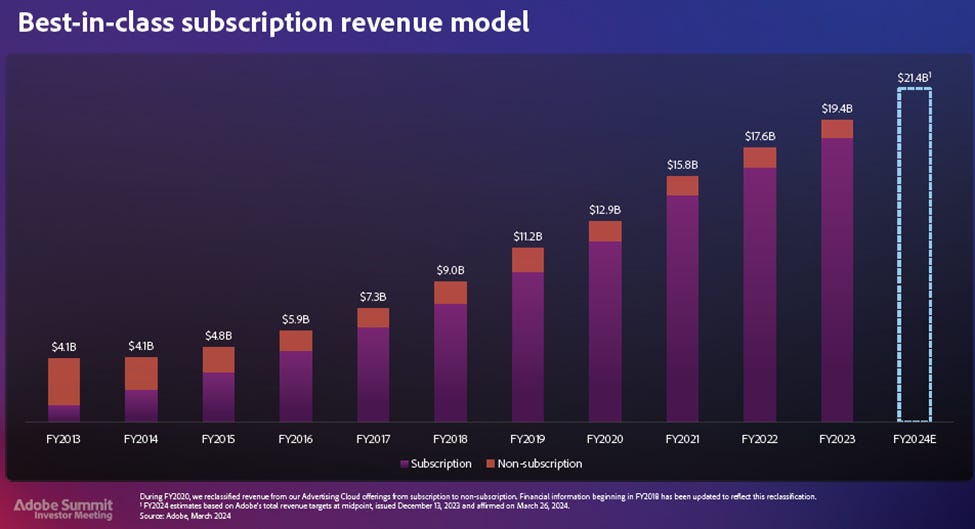In today's report, we turn our focus to Adobe. Following a softer guidance for the second quarter of 2024, and the concerns surrounding the impact of generative AI on Adobe’s dominance in content creation, Adobe's stock price experienced a notable decline, with year-to-date returns of -22%.
In this article, we assess whether the current sell off offers an attractive long-term investment opportunity. To achieve this, we provide an overview of Adobe’s business and evaluate whether its growth trajectory has plateaued. Additionally, we cover its investments in AI to explore the potential opportunities they present and we analyze the competitive landscape to assess the threat posed by disruptors. As always, we conclude by performing a DCF valuation alongside a sensitivity analysis.
For new subscribers: Every month we share 2 detailed company write-ups; one on an existing portfolio company and one on a potential portfolio candidate. To discover more about our offering, visit the “About StockOpine” section.
1. Key Facts
Description: Adobe Inc. (“Adobe”, “Company”), with ticker symbol $ADBE, is the leading design software platform for content creation, management and distribution. Adobe’s software is used by creative professionals, marketers, knowledge workers, application developers, enterprises and consumers.
Key Financials: Over the period FY14 to trailing twelve months (“TTM”) Q1 FY24, the Company depicted a revenue Compound Annual Growth Rate (“CAGR”) of 18.5% and operating income CAGR of 35.1%, reaching a TTM revenue of c. $19.9 billion and operating income of $7.0 billion (margin of 35%). Adobe has cash and short term investments of $6.8 billion compared to total debt and lease liabilities of $4.1 billion.
Price & Market Cap (as of 22nd April 2024): Its market cap is $209 billion with a 52-week low of $332 and a 52-week high of $638, whereas it currently trades at $467.
Valuation: Adobe trades at a TTM EV/EBITDA of 25.9x (4 Year average of 36.1x) and a TTM EV/Sales of 10.4x (4 Year average of 14.5x).
2. Business Overview
Adobe operates under a subscription-based model, with subscriptions accounting for 95% of its revenue, up from 28% in FY13. Its transition to the cloud began with the launch of Creative Cloud in 2012 and the cessation of perpetual licensing (one-time product licensing sales) in 2013, marking a pivotal shift towards the subscription-based model. Adobe’s transition has been hailed as one of the most successful in the software industry.
Source: Adobe Summit 2024
Before transitioning to the cloud, Adobe was shipping approximately 3 million units annually under the perpetual licensing model. However, with the introduction of Creative Cloud subscriptions, the Company experienced significant growth, with subscriptions surpassing 1.4 million in FY13 and skyrocketing to 6.17 million by 2015. Although management ceased reporting subscription numbers after FY15, it's reasonable to estimate that Digital Media subscriptions may now exceed 28 million, based on segment’s Annual Recurring Revenue (“ARR”) of $15.8 billion and a 20% hike for its Creative Cloud All Apps subscription for individuals since its launch.
The transition to a cloud-based model not only rendered revenue more predictable but also fueled accelerated growth. From an average growth rate of 13% during FY06-FY12, Adobe experienced an average growth rate of 19% from FY15 to FY23.
Segments
Adobe’s revenue is separated into three segments, Digital Media, Digital experience, and Publishing and Advertising, with each segment contributing 73%, 25% and 1% respectively.
Source: FinChat.io (affiliate link with a 15% discount for StockOpine readers), StockOpine Analysis
a. Digital Media
The Digital Media segment is Adobe’s bread and butter, encompassing its flagship products such as Photoshop, Illustrator, and Adobe’s Acrobat. Its customer base spans creative professionals such as photographers, video editors, graphic and experience designers, and game developers; communicators including content creators, students, marketers, and knowledge workers; as well as consumers.
With a revenue CAGR of 18.2% since FY13, this segment has witnessed remarkable growth, reaching total revenue of $14.6 billion over the last twelve months. At the same time, ARR for the Digital Media segment reached $15.8 billion as of the last quarter, being up 15% year over year. Notably, Digital Media has been the fastest growing segment within the Company, expanding mostly organically by increasing number of subscriptions and subscription plan pricing, rather than relying on acquisitions.
Source: FinChat.io (affiliate link with a 15% discount for StockOpine readers), StockOpine Analysis
Additionally, Digital Media is Adobe’s most profitable segment generating gross margin of 95% relative to 68% generated by the Digital Experience segment, contributing nearly 80% to the Company’s total gross profit. This exceptionally high gross margin places Adobe among the top performers in the software industry, sharing similar margins with companies like Autodesk (92%), Ansys (92%), and Cadence Designs (89%). Interestingly, these companies are all related to design software, albeit serving different industries.
Adobe separates the Digital Media segment in two parts, the Creative Cloud and the Document Cloud, each catering to distinct market needs. We will now examine each part separately.




